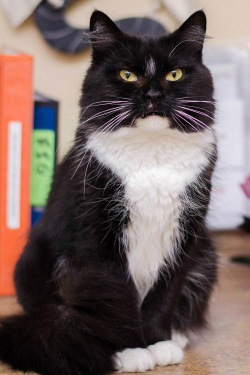
Can indoor living be stimulating enough for the most curious, active cat?
Absolutely! First, make time to play with your cats. Blow bubbles. Toss a ball. Drag a toy around, over furniture, and down hallways. Start and stop like real prey. And let them catch it sometimes.
Here are some more suggestions for keeping cats amused.
Grow Some Goodies
Plant some cat grass, available in pet stores, or oat grass. Or grow the all-time favorite, catnip. Use large pots or even kitty litter boxes as planters so the cat can roll in it.
Visual Stimulation
Give your cat visual access to the outside: put a table or chair by a window, or install a cat window perch. Place outside bird feeders and bird baths in the kitty’s view. Consider leaving the television on, set to Animal Planet or a children’s channel. Simply hanging a ball, toy, or even the ring off a milk container about 2” off the ground can keep a cat happy and active.
Change The Environment
Put a different colored towel in their bed or blanket on their favorite chair – cats can tell the difference between blues and violets better than reds. Leave a radio playing talk or classical/easy listening/world type music. Find out what type of music your cat likes most: some like jazz, some prefer classical, but few are fans of heavy metal.
Mix It Up
Cats get bored playing with the same toys every day, so switch toys about every two weeks. Don’t forget the simple things: paper bags, crumpled paper, and cardboard boxes (with or without peek-a-boo holes, with or without a toy or treat inside).
Treat Puzzles
Challenge the cat with a treat puzzle. Made for dogs and cats, these come in various forms. The basic idea is to make the cat work for its food by sliding over covers, reaching around a maze, finding kibble under pegs, or spinning wheels. Look for them in pet stores or online; and don’t think that because it’s for a dog it won’t work for an inquisitive feline. Alternatively, hide a few treats around the house and let your cat hunt for them while you’re out.
Agility Courses
These work on much the same principle as obstacle courses run by athletes and members of the military, only scaled down for cats. An agility course for a feline can be as simple as a series of chairs placed a cat’s-leap apart. Use a treat to lure the cat from chair to chair; hold up a hula hoop for the cat to leap through on its way to the next chair. Or lure the cat to weave in and out of the chair legs. More complex, cat-sized equipment is for sale with balance beams, jumping bars, hoops, inclined ramps to scale, and even a teeter-totter. Or you can build your own – your cat won’t care if it’s not professional competition quality.
Clicker Training
Teaching an active and intelligent cat specific behaviors can be useful. Clicker training takes a commitment from the smart cat’s humans, but it can be a great way to spend time with your furry whiz kid. The training first teaches the cat to associate the click sound with a reward. The next step is clicking/rewarding when the cat does the desired behavior, and then teaching the command for that behavior. There are many videos and books available on the process, including Clicker Training for Cats by Karen Pryor, and Naughty No More! by Marilyn Krieger.
Food For Thought
Many of these suggestions involve rewards, which mean food treats for most cats. You can use regular cat treats, baby food, or small amounts of canned tuna or chicken (the kind for people). If your cat is overweight and adding treats isn’t in its diet, use its regular kibble, and subtract what is used in the activities from the daily allotment.
Sources: www.bestfriends.org, clickertraining.com
